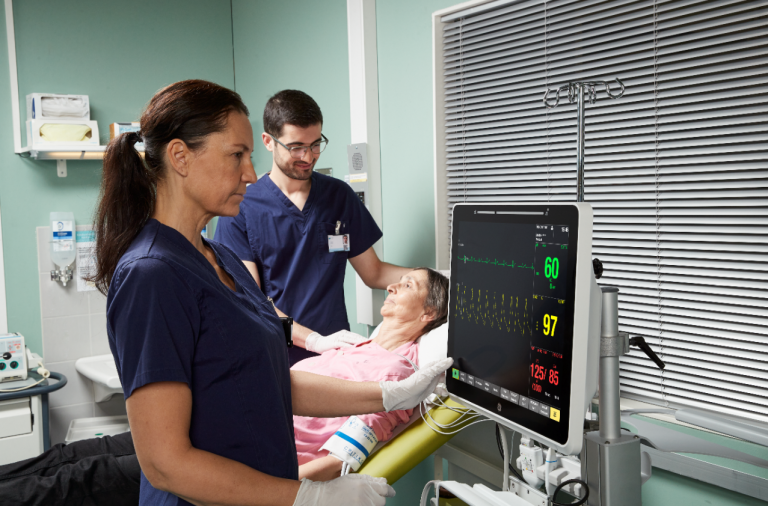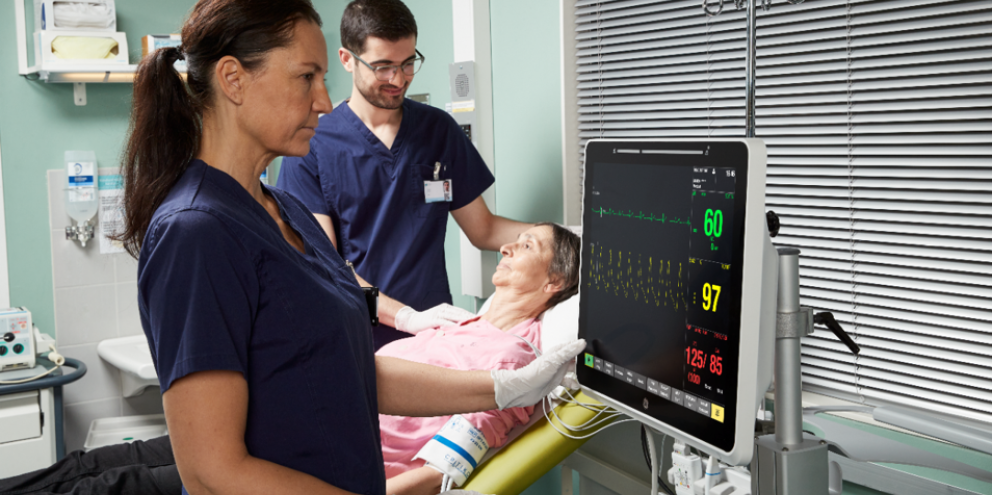
The first two articles in the series outline why hospitals and health systems benefit from incorporating greater flexibility into their facilities and how continuous monitoring both in the ward and beyond sets a foundation.
In this article, we examine the core components of one of the three key opportunities of a flexible healthcare system: acuity adaptable units.
The Core Elements:
Satisfied and Effective Staff to Improve Outcomes and Engagement
Perhaps the most difficult challenge that hospitals and health systems will encounter when implementing acuity adaptable units is the need to institute new staffing models. But when done well and designed to enhance empathy it can benefit the workforce and patients alike.
By building an acuity adaptable staffing model, the University of California Irvine, for example, found that its cardiovascular unit improved patient outcomes and engagement.
The model reduced failure-to-rescue rates by 2.9%, ICU lengths of stay by 3.92 days and hospital lengths of stay by 12.5 days. The health system also bolstered staff engagement, resulting in minimal turnover of just 4.9%. “With the improvements in patient outcomes and staff engagement in this acuity adaptable staffing model, the overall patient experience and operational budget can improve for the organization,” according to a retrospective review[1] of the UC California Irvine initiative.
Appropriate Space for Adaptability
Acuity adaptable units require enough room for clinicians to bring care to the patient rather than moving the patient based on acuity level. The models also enable hospitals to leverage digital tools to optimize care delivery and prepare for the future healthcare crises.
According to a report from IMEG[2], the healthcare-specialist engineering and design consulting firm, hospitals equipping rooms for acuity adaptability should plan to include: modern beds, standard medical equipment, wireless monitoring devices with adaptable software, medication administration systems, general supplies, and a range of gases not limited to medical air, oxygen, carbon dioxide, nitrogen, nitrous oxide, among others.
“To be competitive in this market you have to be flexible and you have to invest in technology that is appropriate for use across acuity levels and, since acuity adaptable efforts will expand in time, all equipment needs to be scalable. That means health systems need short-term and long-term strategies for those implementations.”— VP of Digital Health at an East Coast academic medical center
A Safe Environment for all Acuity Levels
In addition to ensuring appropriate room size and equipment, hospitals must create acuity adaptable units that enhance patient safety — for varying degrees of acuity.
In its landmark report, Transforming Hospitals: Designing for Safety and Quality[3], the Agency for Healthcare Research and Quality (AHRQ) recommended that hospitals focus on addressing common avoidable and often expensive
incidents that cause harm, notably patient falls, hospital-acquired infections, and medication errors.
“Patient rooms that can be adapted for the acuity of a patient can also reduce errors. Acuity adaptable rooms reduce the need to transfer patients around the hospital and lessen the burden on the staff to communicate information to caregivers in the patient’s new location.” – AHRQ
AHRQ also explained that because they keep patients in one place, acuity adaptable rooms enable hospitals to focus on reducing patient falls, and alleviating hospital-acquired infections. By designing wider bathroom doors, properly placed handrails, and nursing stations that make accessing at-risk patients easier and more effective, organizations can reduce patient falls, for example. Single-bed acuity adaptable rooms equipped with modern air filtration systems, with the flexibility of both positive and negative pressure capabilities, as well as multiple handwashing stations, can help alleviate hospital-acquired infections. And basics, such as adequate lighting, private spaces for filling prescriptions, and distraction-free areas for patient discussions help reduce medication errors and, in turn, improve patient safety within adaptable environments.
Patient-centric Technologies
IMEG, in its report, explains that acuity adaptable units consist of “technology that is focused on the experience of the patient, their family and the care team, enabling an engaged and empowered level of care and awareness.” In addition to monitoring devices, several executives interviewed for this article series added that hospitals are prioritizing patient experience with in-room broadband connectivity that enables streaming services such as Netflix, as well as iPads or other tablets that patients can use to conduct telehealth consults with clinicians or video conversations with family members.
Equipping Staff for Changing Acuity Levels
Acuity adaptable rooms should include modern monitoring devices with standard ports, as well as hardware and software that can flex in accordance with a patient’s acuity levels and institutional needs.
“Standardization is the ideal state. One monitoring system means nurses can read that and provide the highest-quality, safest care for patients. That enables organizations to be more flexible and adaptable. If you don’t have standardization, you are simply going to remain inefficient.” – Chief Nursing Officer, Midwest health system
The monitors should be easy to use and standardized across the hospital or health system. Even highly-experienced nurses struggle with managing a host of dissimilar devices, and seemingly endless streams of data only complicate matters. In addition to basic usability for clinicians and patients, standardization drives efficiencies because a nurse, for example, can walk into various units and know exactly how to interface with the monitoring devices and other systems. Executives interviewed for this series of articles said this also reduces waste in those processes and augments operations to both improve outcomes and reduce expenses.
A Foundation for Future Adaptability
While increasing flexibility will require different tactics for almost every organization, the above elements enable hospitals and health systems to advance adaptability in the near-term, while also planning for further evolutions in the future.
The other articles in this series focus on the need for flexibility, continuous monitoring, and the benefits and challenges of adaptable care:
- Part 1: Three Areas Where Hospitals are Becoming More Flexible
- Part 2: Expanding Continuous Monitoring Capabilities
- Part 4: Top Benefits and Common Challenges of Increasing Care Flexibility
References:
[1] Anotado Lopez, K. (2022). Implementation of an Acuity-adaptable Staffing Model in a Cardiovascular Surgival Unit: A Retrospective Review. University of California, Irvine.https://escholarship.org/content/qt89g6h3bg/qt89g6h3bg_noSplash_e81ae742a8d1681a187f3543e31c4438.pdf?t=rdz7z0
[2] Zorich, M. and Gaarde, C. Acuity Adaptabaility Innovative Planning and Design for Responsive Healthcare Delivery. IMEG. https://www.imegcorp.com/library/acuity-adaptability-innovative-planning-and-design-for-responsive-healthcare-delivery/
[3] AHRQ. Transforming Hospitals: Designing for Safety and Quality. Agency for Healthcare Research and Quality (AHQR). https://www.ahrq.gov/sites/default/files/wysiwyg/professionals/systems/hospital/transform.pdf







